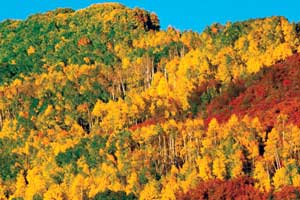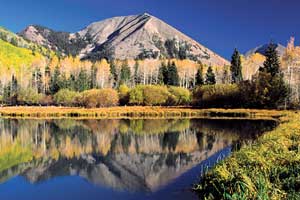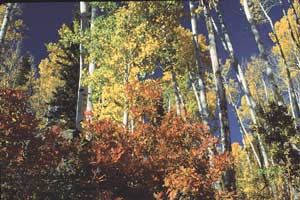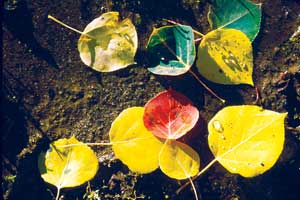 Around the turn of the 20th century, gold was discovered in the La Sal Mountains. The local newspaper painted an enticing picture, “La Sal Mountains as a Gold District,” and of mineral riches for the taking. Forget the Klondike and stampede your way to the hottest prospect this side of the Colorado River (of course, it was called the Grand River back then). An 1897 article read, “If prospectors will only spend less time in staking claims and more in actual mining work it will not be long before the La Sals will be one of the great mineral producing districts of Utah.” Work? Oh, that. Talk about taking the fun out of things.
Around the turn of the 20th century, gold was discovered in the La Sal Mountains. The local newspaper painted an enticing picture, “La Sal Mountains as a Gold District,” and of mineral riches for the taking. Forget the Klondike and stampede your way to the hottest prospect this side of the Colorado River (of course, it was called the Grand River back then). An 1897 article read, “If prospectors will only spend less time in staking claims and more in actual mining work it will not be long before the La Sals will be one of the great mineral producing districts of Utah.” Work? Oh, that. Talk about taking the fun out of things.
Turns out, the La Sals didn’t pan out like advertised. There were some strikes and a few miners made some money, but these prospectors couldn’t seize the real rush that hits the La Sals every autumn as the dense stands of quaking aspen turn from green to gold.
 What starts out as isolated spots in the forest soon becomes a riot of color contrasting with a dark green backdrop of conifers. This event causes an annual pilgrimage up the Loop Road to witness a modern-day gold rush as the delicate leaves begin to shut down for the season. “Visual mining” is the way to see the aesthetic value of this resource, one that ranks just as high as wildlife habitat or timber resources.
What starts out as isolated spots in the forest soon becomes a riot of color contrasting with a dark green backdrop of conifers. This event causes an annual pilgrimage up the Loop Road to witness a modern-day gold rush as the delicate leaves begin to shut down for the season. “Visual mining” is the way to see the aesthetic value of this resource, one that ranks just as high as wildlife habitat or timber resources.
Here in the arid West there are few hardwoods that thrive in these mountain areas. Vine maple, Gambel’s oak and single-leaf ash produce small trees or large shrubs. This is a far cry from the Eastern hardwood forests that undergo their own riot of color this time of year. No, here it is aspen and conifers – Douglas fir, ponderosa pine, subalpine fir, Englemann spruce, that compliment the aspen’s turning.
What makes the contrast of gold against green so effective is the aspen’s ability to reproduce via suckers. No, not the type that buy falsified claims, but through extensive sprouting from the nodes along the root system.
 Though aspens produce copious amounts of tiny, fluffy seeds, the majority of their reproduction comes from cloning. From a single root arises numerous; a mature root system may produce between 400,000 and one million shoots per acre. If conditions are right, these shoots grow rapidly, although many are lost to herbivores or environmental conditions.
Though aspens produce copious amounts of tiny, fluffy seeds, the majority of their reproduction comes from cloning. From a single root arises numerous; a mature root system may produce between 400,000 and one million shoots per acre. If conditions are right, these shoots grow rapidly, although many are lost to herbivores or environmental conditions.
Aspens are considered an early successional species because they utilize cloning to quickly become established after a disturbance like a forest fire or avalanche. They may not be the first plants to sprout in the wake of these alterations, but they are not far behind. This ability provides a great advantage over plants that have to regenerate from seeds, mainly those shade-tolerant conifers that bide their time and grow up within the aspen’s shadow.
And consider this: some clonal groves may date back to over thousands of years old making them an incredibly long-lived specimen. Add reverence to that pilgrimage for color.
One clone is found in the Fishlake National Forest in south central Utah. Nicknamed “Pando,” which in Latin means “I spread,” covers over 43 hectares and has greater than 47,000 individual stems. Represented as a later successional or climax forest, the conifers have been reduce by periodic fires, this clone is thought to have its origins around the last Ice Age, some 10,000 years ago.
 Oddly enough, the label “clone” whispers low genetic diversity; however, a typical aspen stand is a blend of several clones and thus is high in genetic makeup. Another layer of diversity that is also present in these groves is the understory, a rich mosaic of shrubs and wildflowers that would be lacking in a coniferous forest. In turn, this layer with serviceberry, snowberry, wild rose, grasses, wildflowers, and many other plants attracts an abundance of wildlife species including elk, deer, black bear, rabbits, porcupines, coyotes, voles, mice, shrews, and a long list of bird species, as well.
Oddly enough, the label “clone” whispers low genetic diversity; however, a typical aspen stand is a blend of several clones and thus is high in genetic makeup. Another layer of diversity that is also present in these groves is the understory, a rich mosaic of shrubs and wildflowers that would be lacking in a coniferous forest. In turn, this layer with serviceberry, snowberry, wild rose, grasses, wildflowers, and many other plants attracts an abundance of wildlife species including elk, deer, black bear, rabbits, porcupines, coyotes, voles, mice, shrews, and a long list of bird species, as well.
These wildlife eat buds and berries, seeds and insects, and, especially in the case of birds, use the vertical structure of the forest for perches and nest sites. Add all things wild to that pilgrimage for color and reverence.
Rich in attributes, aspen stands in the West are experiencing significant declines. For a species that thrives on disturbance and represents a dynamic landscape, “sudden aspen die-off” (SAD) and lack of regeneration are symptoms of an unhealthy forest. Fingers are pointed at fire suppression, drought, excessive browser populations (wildlife and livestock), and to a more limited extent, global climate change. In some areas where fire has initiated resprouting, an overabundance of ungulates has literally chewed this success back to the ground. Forest Service personnel and researchers across the West are studying these issues and trying to determine solutions that will restore the health of these great forests that ripple with golden color in what may be representative of the autumn of their existence. So maybe add vigilance to that pilgrimage for color, reverence and all things wild. The lack of an autumnal gold rush would make a discouraging headline, indeed.
To see a conifer invasion in an aspen forest, view a short video at http://www.fs.fed.us/wildflowers/communities/aspen/decline.shtml